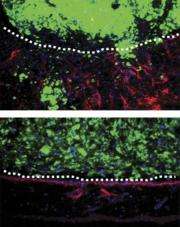Fibroblasts invade at a snail's pace

A transcription factor known to drive the formation of fibroblasts during development also promotes their ability to invade and remodel surrounding tissues, report Rowe et al. in the February 9, 2009 issue of the Journal of Cell Biology.
The conversion of epithelial cells into fibroblast-like mesenchymal cells is a critical event in both normal development and cancer. The transcription factor Snail1 induces this conversion (known as epithelial-mesenchymal transition, or EMT) by repressing the expression of epithelial-specific genes. Little was known about Snail1's role after EMT, although the transcription factor is up-regulated in mesenchymal tissue surrounding tumors and wounds.
Because Snail1 expression is thought to be required for maintenance of the mesenchymal phenotype in cancer, Rowe et al. were surprised to see that normal fibroblasts retained many mesenchymal characteristics when Snail1 was removed. The authors did find, however, that many genes important for cell motility, such as actin-binding proteins and matrix metalloproteinases, were expressed at lower levels in fibroblasts lacking Snail1.
Cells invade tissues by sending out actin-rich protrusions called invadopodia that contain proteolytic enzymes that degrade the surrounding extracellular matrix (ECM). Fibroblasts without Snail1 formed fewer invadopodia and were less able to degrade the ECM. Rowe et al. transplanted the Snail1-deficient fibroblasts into chick embryos and found that they were completely unable to penetrate the basement membrane and the complex mix of ECM proteins beneath. Moreover, unlike wild-type fibroblasts, Snail1-deficient cells didn't stimulate the ingrowth of new blood vessels—another key function of fibroblasts during wound healing and tissue remodeling.
The team thinks that in addition to its role in EMT, Snail1 also acts as a master regulator of fibroblast function. In cancer cells, says author Grant Rowe, sustained Snail1 expression may not only cause a loss of epithelial markers but also promote tumor aggression by stimulating tissue invasion and angiogenesis.
Reference: Rowe, R.G., et al. 2009. J. Cell Biol. doi:10.1083/jcb.200810113.
Source: Rockefeller University

















